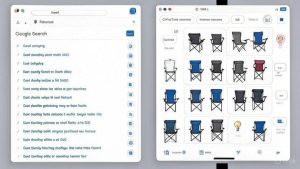In the ever-evolving world of technology, Google has long been the undisputed king of search. For over two decades, its iconic “10 blue links” have guided billions of users to the information they seek. But as artificial intelligence (AI) reshapes the digital landscape, Google is taking a bold step forward with its new AI Mode (Google’s AI Mode), a chatbot-like feature that promises to transform how we interact with its search engine. Unveiled at Google’s I/O developer conference in May 2025, AI Mode aims to make searching more conversational, intuitive, and tailored to complex queries. But does it truly revolutionize search, or does it risk overcomplicating a system that’s worked so well for so long? Let’s dive into what AI Mode is, how it works, its strengths, its limitations, and what it means for the future of finding information online.
What Is Google’s AI Mode?
AI Mode is a new feature integrated into Google Search, powered by the advanced Gemini 2.5 model. Unlike traditional search, which delivers a list of links based on keywords, AI Mode functions like a conversational expert. Users can ask detailed, nuanced questions, engage in follow-up queries, and receive comprehensive, AI-generated responses that pull from Google’s vast data resources, including its Knowledge Graph, real-time web data, and shopping information for billions of products. Think of it as a blend between a traditional search engine and a chatbot like ChatGPT or Perplexity, but deeply embedded in Google’s ecosystem.
For example, imagine you’re shopping for a rug to match your gray couch. With AI Mode, you can type, “Find me a rug that matches a gray couch and is easy to clean,” and the system will generate a tailored response, complete with product suggestions, links to retailers, and even options to refine your search, like setting a price cap. Or, if you’re tackling a complex task, such as comparing sleep-tracking features across smartwatches, smart rings, and tracking mats, AI Mode can break down the differences, provide insights, and offer follow-up questions to dig deeper.
This shift began with Google’s AI Overviews, introduced in 2024, which provided AI-generated summaries atop search results. AI Mode takes this further, replacing the traditional list of links with a dynamic, interactive experience. It’s now available to all U.S. users, having graduated from Google’s Search Labs after a brief testing phase in March 2025.
How Does AI Mode Work?
At its core, AI Mode leverages a technique called “query fan-out,” where a single user query is broken into multiple sub-queries. These are processed simultaneously across various data sources, such as web pages, Google’s Knowledge Graph, and product databases. The Gemini 2.5 model then synthesizes this information into a concise, conversational response, often with citations to relevant websites. This approach allows AI Mode to handle complex, multi-part questions that would typically require several traditional searches.
For instance, if you ask, “What’s the best yoga studio in Boston with intro offers and walking distance from Beacon Hill?” AI Mode can analyze location data, customer reviews, and promotional offers to provide a tailored answer, complete with maps and links. It also supports multimodal inputs, like using Google Lens to search via images or live video. A user could point their camera at a Popsicle-stick bridge and ask, “How can I make this stronger?” and AI Mode might suggest adding triangles to the design, pulling from engineering principles found online.
Google’s CEO, Sundar Pichai, called AI Mode a “total reimagining of search,” emphasizing its ability to move beyond simple information retrieval to reasoning and synthesis. Nick Fox, who oversees Google’s knowledge and information products, noted that the technology allows Search to “connect dots across” and “transform” information in ways that make it more helpful.
The Strengths of AI Mode
- Handling Complex Queries: AI Mode shines when tackling nuanced or multi-faceted questions. For example, planning a daughter’s birthday party by finding a park with picnic tables or comparing product features across multiple categories is faster and more intuitive than sifting through multiple search results. Google reports that AI Mode users ask queries two to three times longer than traditional searches, indicating its appeal for in-depth tasks.
- Conversational Interaction: The ability to ask follow-up questions without losing context makes AI Mode feel like a dialogue with an expert. This is particularly useful for iterative tasks, like refining a purchase decision or exploring a new topic.
- Multimodal Capabilities: With features like Search Live, AI Mode can process real-time visual or voice inputs. This opens up new possibilities, such as troubleshooting a project by showing it to your camera or getting real-time translations via augmented reality glasses.
- Increased Engagement: Google claims AI Mode drives higher-quality clicks, with users spending more time on websites they visit from AI-generated results. A BrightEdge study noted a 10% increase in search usage for queries with AI Overviews, suggesting AI Mode could further boost engagement.

The Limitations and Risks
Despite its promise, AI Mode isn’t flawless. Early feedback highlights several challenges:
- Accuracy Issues: AI Mode can stumble on basic searches. For example, when Brian X. Chen from The New York Times asked AI Mode to find a park in Oakland with picnic tables, it listed parks without tables. Similarly, a search for an affordable car wash returned a $25 option that actually cost $65. These errors suggest AI Mode may struggle with straightforward, location-based queries where traditional search excels.
- Reduced Web Traffic: Publishers are concerned that AI Mode’s comprehensive answers could keep users on Google’s platform, reducing clicks to external sites. A BrightEdge study found a 30% drop in click-through rates due to AI Overviews, and AI Mode’s even more immersive format could exacerbate this. Smaller publishers, in particular, fear being sidelined as Google prioritizes its ecosystem.
- Untrackable Traffic: AI Mode doesn’t pass referral data, making it impossible for websites to track clicks in Google Search Console or analytics platforms. This lack of transparency, dubbed “Not Provided 2.0” by SEO expert Lily Ray, frustrates publishers trying to measure AI Mode’s impact.
- Risk of Misinformation: Like its predecessor AI Overviews, which infamously suggested adding glue to pizza, AI Mode risks generating “hallucinations” or factual errors. Google acknowledges these issues and is working to improve accuracy, but the rapid rollout after a short testing phase raises concerns about reliability.
- Monetization Challenges: Google’s search revenue relies heavily on ads, but integrating them into AI Mode without disrupting the user experience is tricky. Early tests suggest ads will appear labeled as “Sponsored” below AI answers, but it’s unclear how this will balance user satisfaction with revenue needs.
What Does This Mean for Users and the Web?
For users, AI Mode offers a powerful tool for complex tasks, especially for shopping, planning, or learning. Its conversational nature and multimodal capabilities make it feel like a personal assistant, potentially saving time on research-heavy queries. However, for simple searches, like finding a local business or quick facts, traditional search remains more reliable. Users may need to toggle between AI Mode and classic search to get the best results, which could feel clunky.
For the broader web, AI Mode’s rise poses existential questions. Publishers, especially smaller ones, worry about losing traffic as Google keeps users within its ecosystem. The shift toward “zero-click” searches, where users get answers without visiting external sites, began with AI Overviews and could accelerate with AI Mode. This has sparked debates about the sustainability of the web’s business model, with critics arguing Google is prioritizing its dominance over the health of the internet.
SEO (Search Engine Optimization) is also evolving. As AI Mode relies on high-quality content, images, and videos, businesses must optimize for multimodal discovery, including Google Lens and Google Business Profiles. The traditional focus on ranking for keywords is giving way to “answer engine optimization,” where visibility in AI-generated responses is key.

The Future of Search
Google’s AI Mode is a glimpse into the future of search, where intelligence and reasoning take precedence over simple link retrieval. Its integration of Gemini 2.5 and advanced techniques like query fan-out positions it as a formidable competitor to AI-driven alternatives like ChatGPT and Perplexity. Yet, its success hinges on balancing innovation with reliability. If Google can iron out accuracy issues and address publisher concerns, AI Mode could redefine how we access information. If not, it risks alienating users and content creators alike.
For now, AI Mode is an exciting but imperfect experiment. It excels at complex tasks but falters on basic queries, and its impact on web traffic raises valid concerns. As Sundar Pichai put it, we’re in a “new phase of the AI platform shift,” and AI Mode is a bold step in that direction. Whether it revolutionizes search or overcomplicates it depends on how Google navigates these challenges in the coming years.
FAQs:
1. What is Google’s AI Mode?
Answer: Google’s AI Mode is a new feature in Google Search that uses the Gemini 2.5 AI model to provide conversational, tailored responses to complex queries. Unlike traditional search, which lists links, AI Mode generates detailed answers, supports follow-up questions, and integrates multimodal inputs like images or video, making search feel like a dialogue with an expert.
2. How do I access AI Mode?
Answer: AI Mode is available to all U.S. users on Google.com and the Google app as of May 2025. Simply type your query in the search bar, and AI Mode may activate automatically for complex questions, or you can toggle it on via the Search Labs interface (if available in your region). No separate app or subscription is needed.
3. What kind of queries is AI Mode best for?
Answer: AI Mode excels at complex, multi-part queries, such as comparing products (e.g., “Which smartwatch has the best sleep tracking under $200?”), planning tasks (e.g., “Find a yoga studio in Boston with intro offers”), or creative problem-solving (e.g., “How do I make a Popsicle-stick bridge stronger?”). It’s less reliable for simple searches like local business hours.
4. How is AI Mode different from traditional Google Search?
Answer: Traditional Google Search delivers a list of links based on keywords, while AI Mode provides a conversational, AI-generated response that synthesizes information from multiple sources. It supports follow-up questions and multimodal inputs (e.g., images via Google Lens), aiming to answer queries directly rather than pointing to external sites.
5. Can AI Mode make mistakes?
Answer: Yes, AI Mode can produce errors or “hallucinations,” such as suggesting incorrect locations or outdated information. For example, early tests showed it listing parks without picnic tables or misquoting prices. Google is working to improve accuracy, but users should verify critical information, especially for local or factual queries.
6. Does AI Mode affect website traffic?
Answer: Yes, there’s concern that AI Mode reduces clicks to external websites by providing comprehensive answers directly on Google’s platform. Studies on AI Overviews, AI Mode’s predecessor, showed a 30% drop in click-through rates for some publishers. Smaller websites may be hit hardest, as users stay within Google’s ecosystem.
7. How does AI Mode handle ads?
Answer: Google is testing ads in AI Mode, labeled as “Sponsored” below AI-generated answers. The exact approach is still evolving, but Google aims to balance monetization with user experience. Ads may appear less intrusive than in traditional search but could still influence the results you see.
8. Can I use AI Mode with images or voice?
Answer: Yes, AI Mode supports multimodal inputs through features like Google Lens and Search Live. You can upload images, point your camera at an object (e.g., a bridge model), or use voice commands to ask questions. This makes it ideal for visual or hands-free searches, like identifying objects or troubleshooting on the go.
9. Is AI Mode available outside the U.S.?
Answer: As of June 2025, AI Mode is primarily available in the U.S., with limited rollout in other regions. Google plans to expand access, but no official timeline has been confirmed. Check Google’s Search Labs or regional announcements for updates on availability in your country.
10. Will AI Mode replace traditional Google Search?
Answer: Not entirely. AI Mode is designed for complex queries, but traditional search remains better for quick, straightforward tasks like finding a local business or checking facts. Google is likely to maintain both options, allowing users to toggle between AI Mode and classic search based on their needs.
Final Thoughts
Google’s AI Mode is a game-changer for those who embrace its conversational, multimodal capabilities. It’s perfect for diving deep into topics or making informed purchase decisions, but it’s not a one-size-fits-all solution. For everyday searches, the classic Google experience still has its place. As users, we get to explore a more dynamic way to search, but we should stay mindful of its limitations and the broader implications for the web. Try AI Mode for yourself on Google.com or the Google app, and let us know in the comments how it’s working for you. Is it the future of search, or is Google trying to fix what isn’t broken?

